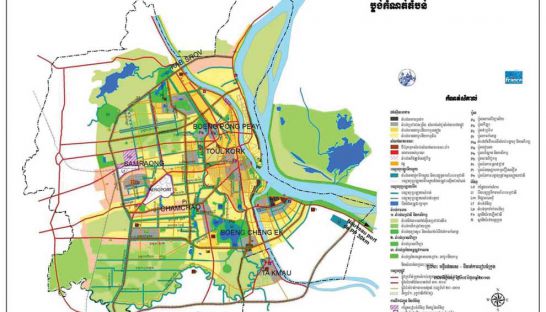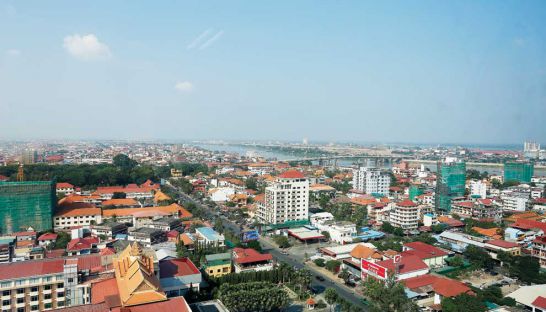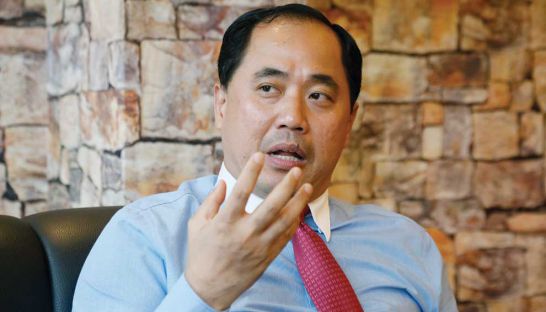Phnom Penh’s 2035 master plan in minimal use
Phnom Penh’s 2035 master plan in minimal use
Phnom Penh City Hall’s new building has massive offices occupying most floors, bringing to mind impending important meetings that would decide the fate of the capital city – if it follows the city’s master plan intended for use until 2035.

Hinging on what former City Hall spokesman Long Dimanche said earlier this year, that “the governor has approved the plan to build a public library in our new building where [Phnom Penh’s] master plan will be placed in, so anyone can come and study the document there”, Post Property’s visit to the new building last week was a futile one that yielded a locked library door on the tenth floor.
Termed “Phnom Penh Land Use for 2035”, the master plan – originally a 330-page document funded by the French Embassy, titled Livre Blanc, and belatedly approved after eight years – was conveniently summarised into a 35-page document in Khmer that was released to the public at the end of 2015.
“We had to write it in Khmer as a sub-decree in order to get Prime Minister [Hun Sen] to sign and approve of it,” said a municipality official working in the Urbanization Division, who requested anonymity.
To see the master plan in its physical form, according to the official, would require submitting a formal permission grant to the governor. The library, where it is placed, is also out of bounds to the press and is open only to a few select members of the public.
Less elusive is the prototype of the entire city, which is in place at the new building’s exhibition hall together with extracted pictures of the city’s master plan and map zonings, and where “friends of the staff and my students come to see [them] all the time,” the anonymous official, who is also a university lecturer, said.
The grounds on whether the Phnom Penh Land Use 2035 is actually being implemented or exists merely for formality’s sake remain unknown.
On whether it is necessary for developers to be shown the master plan before planning to build a project, he said, “The master plan is the city plan [until] 2035, so whether they want to or not, they have to look at it,” insisting that because it was signed by the Prime Minister, it is a sub-decree that needs to be implemented: “They must look at it.”
The official continued, “The master plan indicates which direction the developments are taking. Therefore, it is being used in anything related to the city development.”“It has been implemented in the transportation sector, such as the city belts. Expanding the roads or leaving space for the roads, or granting land titles all follow through with the master plan.”
Cambodian Valuers and Estate Agents Association (CVEA) president Kim Heang, who has not seen the master plan, explained, that as per protocol, it was a must for every real estate developer to check the master plan before submitting a proposal to build a project.
“Developers need to know the trend of developments, where they should go to and what kind of project [is suitable] for the [respective] areas.”
Heang admitted there were questions shrouding the effective implementation of the master plan.
“No one can confirm whether it exists or not. The master plan is the plan for a long term development in Phnom Penh, so it can be changed at any time till further notice.”
Furthermore, some developers of prominent projects in the city have declined to comment on the subject, citing fragility of matter, leading to more ambiguity concerning the master plan’s lack of enforcement.
Only last Tuesday, the Ministry of Land Management, Urban Planning and Construction had demanded more due diligence from city and provincial authorities in cracking down on illegal construction sites nationwide of which there were more than 300 last year.
Although the master plan and a construction permit are separate, Heang said the master plan was very important in helping a developer obtain a construction permit.
By not being transparent about construction and real estate development policies from the get-go, running into problems like illegal building sites have now taken a toll on the Kingdom, especially in the capital.
Heang strongly suggested that the government conduct public forums in educating relevant stakeholders in the making of or updating of the master plan, “so that the government can get more ideas from industry professionals for a better future for Cambodia.”















